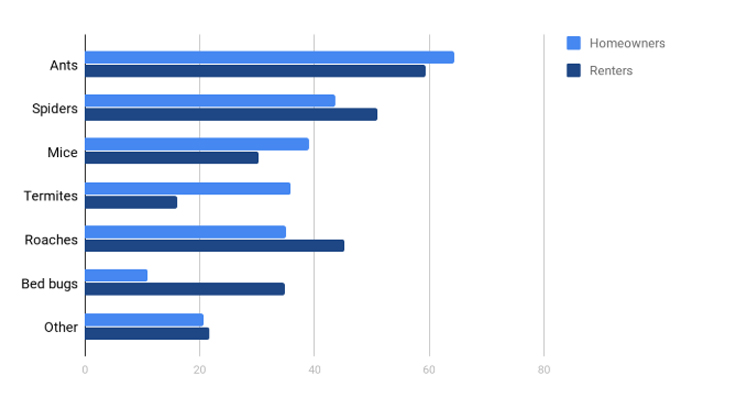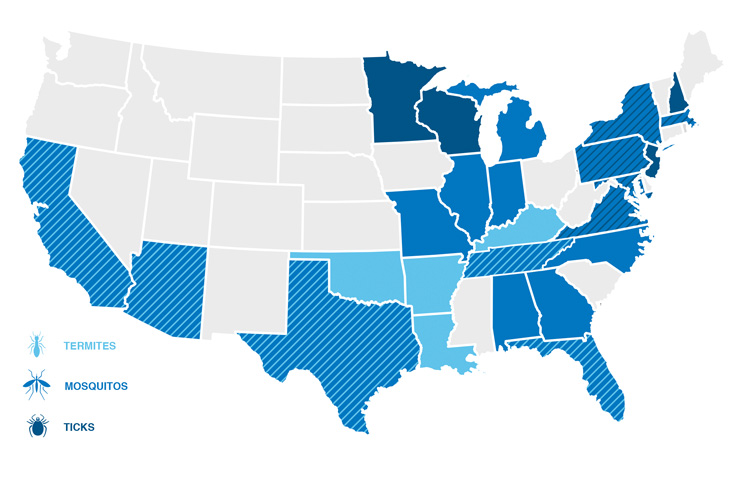Pest control statistics and trends
We surveyed consumers to learn which pests bug them the most

A recent ConsumerAffairs’ survey† found that ants are the most concerning pest, followed by spiders and roaches. Homeowners are most likely to be concerned by ants, spiders, mice and termites. Renters are most likely to be worried about ants, spiders, roaches and bed bugs.
These 6 pests have consumers' skin crawling

Termites, mosquitoes and ticks pose the most significant threats to people in the U.S.
Ants are often considered to be just a nuisance, but some species pose a threat to your property or health. Carpenter ants bite through wood with their strong jaws and can cause as much damage as termites. For those with allergies, fire ants can cause severe pain and localized reactions.
Not surprisingly, spiders also ranked as a serious concern for most people, although most species in the U.S. are harmless. Psychologists believe that spiders trigger anxiety in people because of their erratic movements and “legginess.” For similar reasons, we find roaches repulsive because they appear slimy and, like snakes, move faster than it appears they should.††
However, termites, mosquitoes and ticks pose the most significant threats to people in the U.S. Termites cause structural damage that can be expensive to repair, while mosquitoes and ticks can be vectors for disease and cause significant health issues. Pest control treatment costs are also high.
Most common pests by region


Where are mosquitoes most common?
Mosquitoes thrive in warm, humid climates with high rainfall. According to mosquito-borne disease statistics from the WHO, mosquitoes are most likely to bite humans around dusk during warmer months. We based our ranking on the number of Orkin mosquito customers from April 1, 2018, to March 1, 2019.
Top 20 cities most common for mosquitoes
- Atlanta, GA
- New York City, NY
- Washington, D.C.
- Chicago, IL
- Houston, TX
- Dallas-Ft. Worth, TX
- Detroit, MI
- Philadelphia, PA
- Charlotte, NC
- Raleigh-Durham, NC
- Phoenix, AZ
- Los Angeles, CA
- Boston, MA
- Miami, FL
- Baltimore, MD
- Richmond, VA
- Nashville, TN
- Tampa, FL
- Indianapolis, IN
- St. Louis, MO
Mosquito statistics
The mosquito spreads more diseases than any other type of insect and is responsible for several million deaths and hundreds of millions of illnesses each year, according to the World Health Organization. West Nile Virus, Eastern equine encephalitis (EEE) and Zika are the biggest mosquito threats in the U.S.
- West Nile virus: West Nile virus is most commonly transmitted to humans through a mosquito that has fed on an infected bird. Symptoms appear in three to 14 days and include fever, body aches, headache, rash and swollen lymph nodes. There is no specific antiviral treatment or vaccine. In the U.S., there were approximately 2,647 cases of West Nile and 167 deaths in 2018.
- Eastern equine encephalitis: EEE is a rare but deadly disease in humans. Symptoms usually occur four to 10 days after the bite and include fever, head and muscle aches, vomiting, joint pain and fatigue. Like West Nile, there is no vaccine or specific antiviral treatment for EEE. As of Sept. 25, 2019, 10 people have died from EEE this year. Recent EEE fatalities have been reported in Massachusetts, Michigan, Connecticut and Rhode Island. In one case, the victim became brain dead just nine days after exhibiting symptoms, according to CNN.
- Zika Virus: In the U.S., Zika is transmitted by Aedes aegypti, aka the yellow fever mosquito, which is also responsible for the dengue virus, chikungunya virus and yellow fever. Symptoms occur within seven days and include mild fever, rash, muscle or joint pain and conjunctivitis. Those with Zika virus are at a higher risk for neurological complications, including Guillain-Barré syndrome, neuropathy and myelitis.

Where are termites most common?
Generally, termites are most prevalent in the Mid-Atlantic, Southeast and Gulf Coast regions, as well as Midwest and Pacific states. Drywood, dampwood and subterranean termites — the most harmful species — thrive in warm climates. They are primarily attracted to moisture and wood and invade properties through cracks in building exteriors. We based our ranking on the number of Terminix termite customers from Jan. 1, 2018, to Dec. 31, 2018.
Top 20 cities with the most termites
- Mobile, AL
- Honolulu, HI
- Baton Rouge, LA
- Little Rock, AR
- Fort Smith, AR
- Memphis, TN
- Tyler-Longview, TX
- Miami, FL
- Phoenix, AZ
- Dallas, TX
- Los Angeles, CA
- West Palm Beach, FL
- Houston, TX
- Paducah, KY
- Jacksonville, FL
- Orlando, FL
- Tampa, FL
- Oklahoma City, OK
- San Diego, CA
- Montgomery, AL
Termite statistics
Termites are small but mighty when they work toward a common goal — and that goal often causes structural damage to your house. On average, a homeowner with termites spends $3,000 to repair the damage. According to Orkin, each year in the United States, termites:
- Infest approximately 600,000 homes
- Cause more than $5 billion in property damage
- Are responsible for $30 billion in damage to crops and infrastructure

Where are ticks most common?
Ticks live in every state, but tick-borne diseases occur most frequently in populations in the Northeast, Mid-Atlantic and Upper Midwest. We based our ranking on “Vital Signs: Trends in Reported Vectorborne Disease Cases — United States and Territories, 2004 - 2016,” published by the Centers for Disease Control and Prevention in 2018.
Top 10 states most common for ticks
Ticks live in every state, but tick-borne diseases occur most frequently in populations in the Northeast, Mid-Atlantic and Upper Midwest.
| Rank | State | Number of tick-borne disease cases* |
|---|---|---|
| 1 | Pennsylvania | 73,610 |
| 2 | New York | 69,313 |
| 3 | New Jersey | 51,578 |
| 4 | Massachusetts | 50,234 |
| 5 | Connecticut | 36,727 |
| 6 | Wisconsin | 33,255 |
| 7 | Minnesota | 26,886 |
| 8 | Maryland | 22,166 |
| 9 | Virginia | 16,454 |
| 10 | New Hampshire | 13,710 |
Tick statistics
Cases of Lyme disease, spotted fever rickettsiosis (which can lead to Rocky Mountain spotted fever), anaplasmosis/ehrlichiosis, tularemia, babesiosis and Powassan virus are on the rise, according to the Centers for Disease Control and Prevention. The total reported cases of tick-borne diseases increased from 22,527 in 2004 to 59,349 in 2017.
Additionally, scientists have identified a new tick species — Haemaphysalis longicornis, aka the Asian longhorned tick — in Arkansas, North Carolina, Tennessee, Virginia, West Virginia, Pennsylvania, Maryland, Kentucky, Delaware, Connecticut, New Jersey and New York. As of August 2019, no harmful germs have been collected from this tick species. However, predicting the future rate of tick-borne illnesses is complicated because ticks spread germs with life cycles of up to three years.
Pest control industry trends
The United States pest control industry has grown by 2.8% in the last five years. More than 27,000 pest control businesses are currently in operation, and the industry is projected to generate $17.4 billion in revenue by 2023, according to Statistica.
- Chicago is the most rat-infested city in the U.S., followed by Los Angeles, New York, Washington, D.C., and San Francisco.
- New Orleans is the most cockroach-infested city in the U.S., followed by Houston, Atlanta, Miami and Phoenix.
- Baltimore is the most bedbug-infested city in the U.S., followed by Washington, D.C., Chicago, Los Angeles and Columbus, Ohio.
- Spotted lanternflies are an invasive species in Pennsylvania, New Jersey, Delaware and northern parts of Virginia. Spotted lanternflies aren’t dangerous to people, but infestations can cause honeydew secretions at the base of trees, which blacken the surrounding soil with fungal mats.
- Brown marmorated stink bugs are native to China, Japan and Korea but have been damaging crops in the eastern U.S. since the mid-1990s. In just one year, brown marmorated stink bugs caused $37 million in damage to crops. These bugs are a nuisance to people because they tend to swarm in large numbers and are attracted to indoor areas.
- Around six or seven people die from spider bites in the U.S. each year. For comparison, bees and wasps are responsible for 50 to 60 human fatalities per year.
- Roaches, stink bugs, ants, rats and mice are the most common pests in the White House, according to NBC Washington reporters who obtained a White House pest control order.
- All 50 states have designated official state insects. Most commonly, official state insects are the relatively wholesome honeybee or a type of butterfly. Meanwhile, New Mexico boasts the tarantula hawk — a kind of wasp that paralyzes tarantulas and lays its eggs in the spider’s abdomen. Eventually, the baby wasps eat the tarantula (still alive!) when they hatch.
- Neonicotinoid pesticides are a type of insecticides chemically related to nicotine. Neonicotinoid insecticides have gained popularity in the pest control industry because they are water-soluble and effective against sap-feeding insects, beetles, fleas, flies, cockroaches and some wood-boring pests. However, neonicotinoid insecticides are also potentially toxic to honeybees. Use of neonicotinoid pesticides has been restricted across the U.S. and European Union.
- Nationwide, about 74% of homeowners perform some type of DIY pest control, compared to 69% of renters.
† ConsumerAffairs surveyed 500 people via email between August 29 and September 4, 2019.
†† Armfield, Jason M. “A Cognitive Theory of the Etiology of Fear” (2008). The University of Adelaide, Australia.
You’re signed up
We’ll start sending you the news you need delivered straight to you. We value your privacy. Unsubscribe easily.